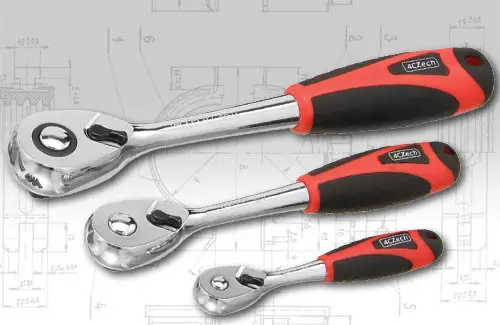The regular price is the current manufacturer's recommended price! FREE shipping for orders over EUR 41,67 within CZ+SK (PPLparcel)

Nowadays, more and more people are leaning towards manual work, so choosing the right tool is key to quality and efficient work.
Definition
A ratchet, also known as a socket wrench is a hand tool used to loosen and tighten nuts.
History
Ratchets have a long history that dates back to the early industrial revolution. The first ratchets were more like tools with square heads, used to tighten or loosen screws and nuts.
At first, they were made only of metal, which made them very durable tools. A revolutionary step was the introduction of the quick-change system, which allowed users to quickly and easily change the direction of rotation of the ratchet using a switch lever, which meant faster, better quality and more efficient work, especially in the automotive industry.
Ratchet parts

The entire ratchet consists of a handle ending in a head with a square drive, on which the heads are placed.
1. Cap - heat-treated, forged, alloyed
2. Gear
3. Latch
4. Stainless ball
5. Spring
6. Ratchet handle /handle/
7. Rivet fastening
8. Switch
Ratchet sizes
The size of the ratchet is indicated according to the square, on which heads of the same size are placed.
This size is given in inches /“/ – 1 inch = 25.4 mm.
Square size | Socket size | Screw size | Application |
1/4“ | 4-14 mm | M2-M8 | Furniture assembly, consumer electronics repair, model work, bicycle maintenance |
3/8“ | 6-24 mm | M4-M14 | Universal use, for 1/2“ and 1/4“ heads |
1/2“ | 8-34 mm | M5 - M22 | Screwing connections on engine and car wheels in the automotive industry, in the garage and for hobby use |
3/4“ | 19-55 mm | M12-M36 | Service of trucks, buses, trains, agricultural machinery |
1“ | 36-80 mm | M24-M52 | Assembly and disassembly of very oversized joints |
Generally speaking, the larger the square, the larger the screws that can be tightened.
Number of teeth
An important parameter for choosing a ratchet is also the number of teeth. The number of teeth regulates the size of the ratchet's working step. For example, the length of the ratchet's reverse step is an excellent 5 degrees for a 72-tooth ratchet (360° / 72 = 5°).
The general rule is that the more teeth, the easier it is to work with the ratchet /rotate the ratchet/ in a limited space. Quality ratchets usually have 24-96 teeth, the most common in our assortment is 72 teeth.
Ratchet types
Our range includes the following types of ratchets:
- oval ratchets with a toggle lever
- ratchets with a toggle button
- ratchets with a toggle wheel for switching between right and left rotation
- ratchets with a toggle lever
- all-metal ratchets
- rotary ratchets – by turning the handle, you can control the rotation of the square head of the ratchet
- ratchets with a swinging head – the swinging head allows access to hard-to-reach places
- 3D ratchets with a toggle lever and swinging head – the specially designed swinging head allows movement of 30° (15° up, 15° down).
- mini ratchets – for even easier work in confined spaces
Other articles:
Jak vybrat vhodný pilník nejen do dílny
Posuvná měřítka
Sady nářadí
Svinovací metry